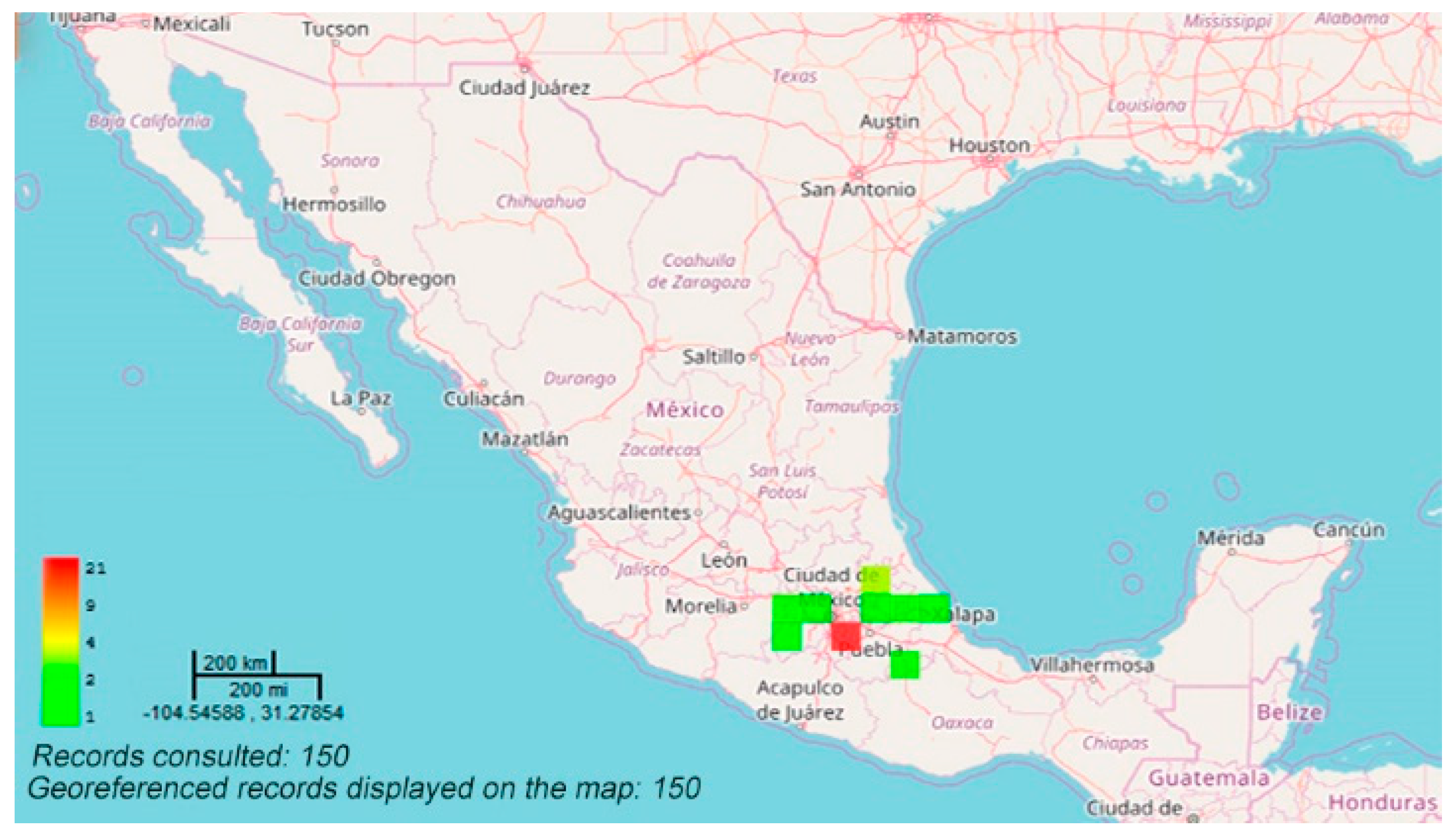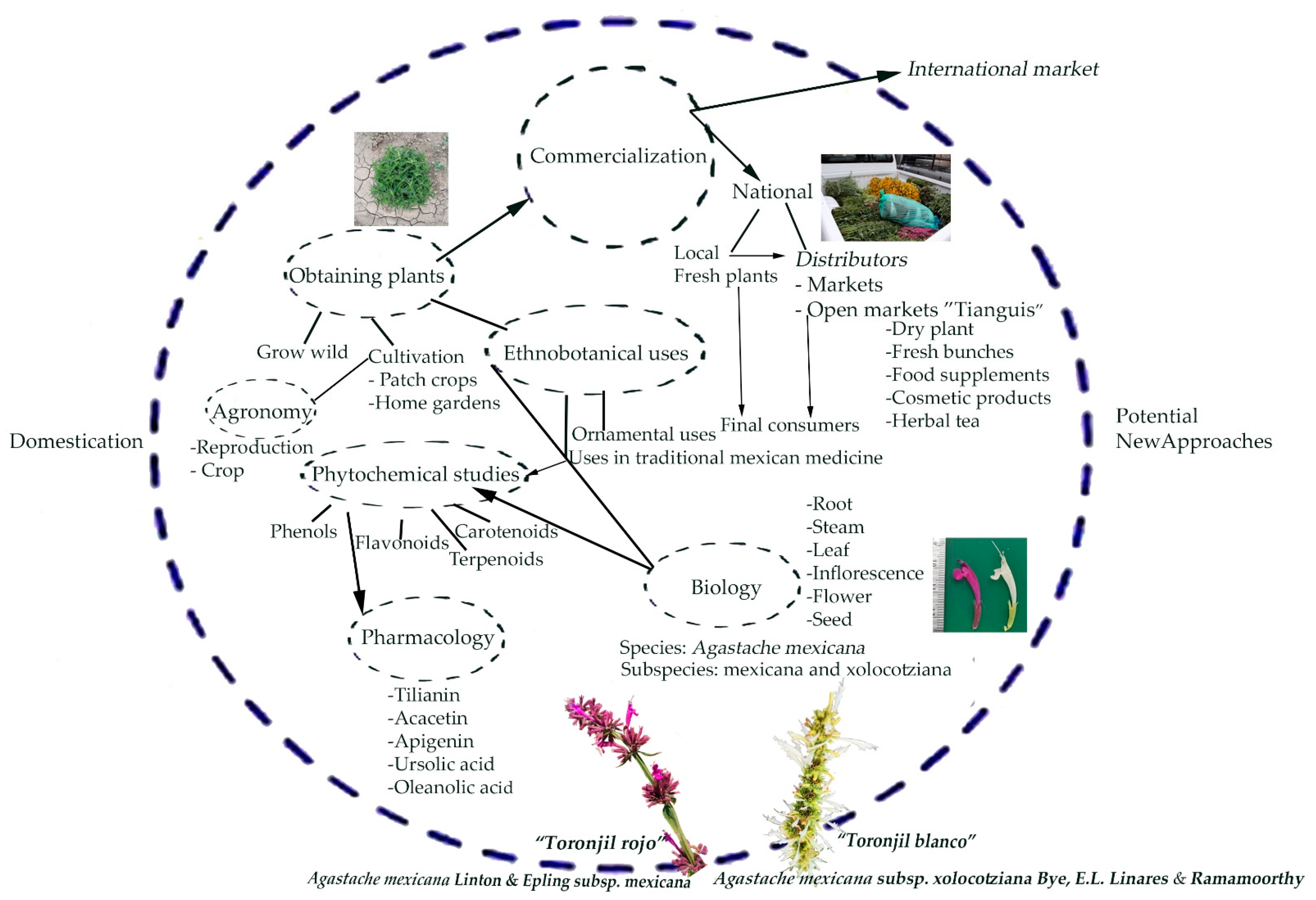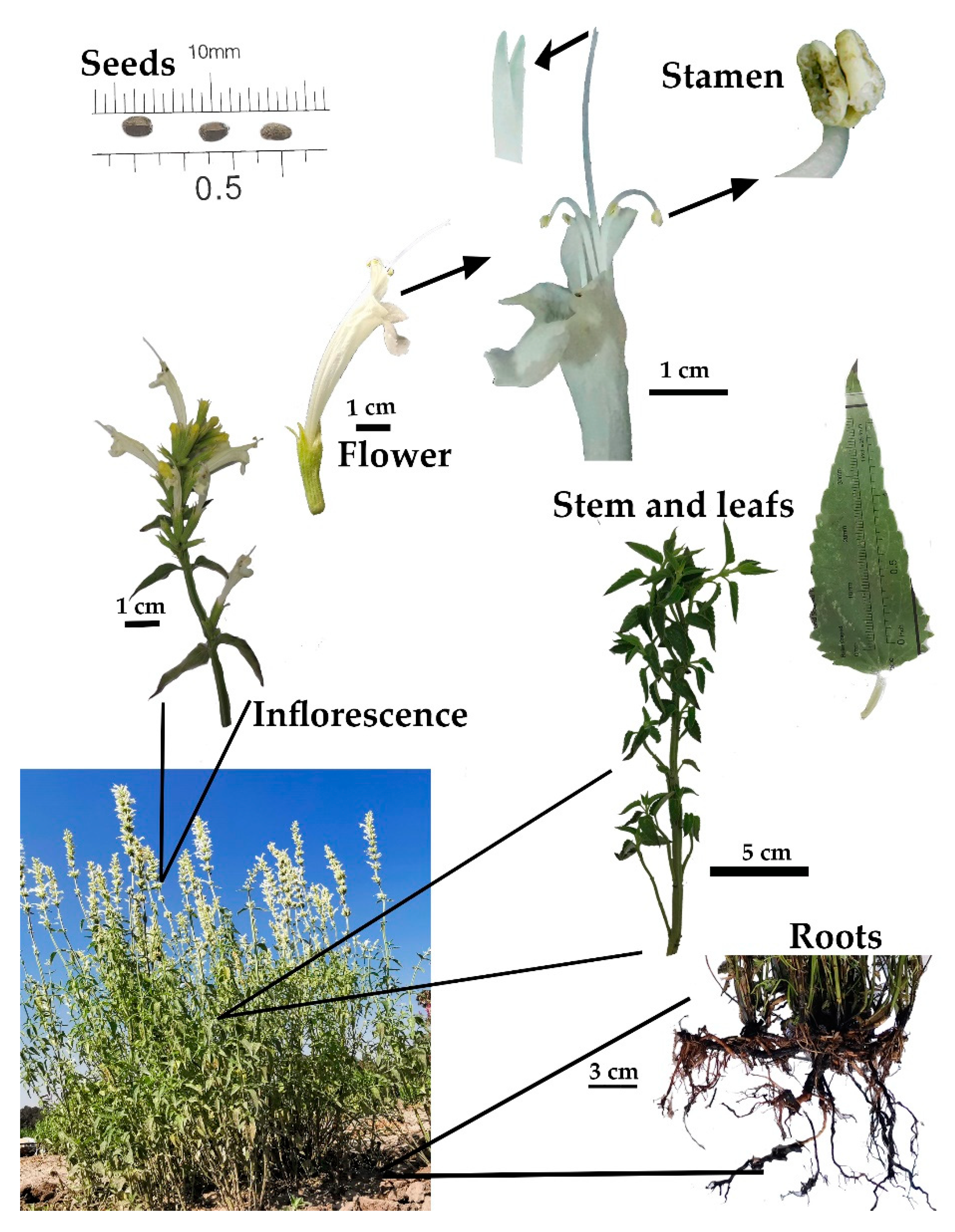A Systematic Approach to Agastache mexicana Research: Biology, Agronomy, Phytochemistry, and Bioactivity
Abstract
:1. Introduction
2. A Holistic Approach to Agastache mexicana Usage
2.1. Biology
2.1.1. A. mexicana ssp. mexicana
2.1.2. A. mexicana ssp. xolocotziana
2.2. Ethnobotanical Uses
2.3. Agronomy
2.4. Commercialization
2.5. Phytochemical and Biological Activity
2.5.1. Phytochemistry
2.5.2. Biological Activity
Antihypertensive, Vaso-Relaxant, Spasmolytic, and Spasmogenic Properties
Analgesic and Anti-inflammatory Properties and Effects in the Central Nervous System
Antioxidant and Nutraceutical Properties
Antifungal and Phytotoxic Properties
3. Potential and Perspectives
Author Contributions
Funding
Data Availability Statement
Acknowledgments
Conflicts of Interest
References
- Martínez-Gordillo, M.; Fragoso-Martínez, I.; García-Peña, M.D.R.; Montiel, O. Géneros de Lamiaceae de México, diversidad y endemismo. Rev. Mex. Biodivers. 2013, 84, 30–86. [Google Scholar] [CrossRef] [Green Version]
- Santillán, M.A.; López, M.E.; Aguilar, S.; Aguilar, A. Estudio etnobotánico, arquitectura foliar y anatomía vegetativa de Agastache mexicana ssp. mexicana y A. mexicana ssp. xolocotziana. Rev. Mex. Biodivers. 2008, 79, 513–524. [Google Scholar]
- Estrada-Reyes, R.; López-Rubalcava, C.; Ferreyra-Cruz, O.A.; Dorantes-Barrón, A.M.; Heinze, G.; Moreno Aguilar, J.; Martínez-Vázquez, M. Central nervous system effects and chemical composition of two subspecies of Agastache mexicana; An ethnomedicine of Mexico. J. Ethnopharmacol. 2014, 153, 98–110. [Google Scholar] [CrossRef]
- Estrada-Reyes, R.; Aguirre Hernández, E.; García-Argáez, A.; Soto Hernández, M.; Linares, E.; Bye, R.; Heinze, G.; Martínez-Vázquez, M. Comparative chemical composition of Agastache mexicana subsp. mexicana and A. mexicana subsp. xolocotziana. Biochem. Syst. Ecol. 2004, 32, 685–694. [Google Scholar] [CrossRef]
- Bye, R.; Linares, E.; Ramamoorthy, T.P.; García, F.; Collera, O.; Palomino, G.; Corona, V. Agastache mexicana Subs. xolocotziana (Lamiaceae). A new taxon from mexican medicinal plants. Phytologia 1987, 62, 156–163. [Google Scholar]
- Martínez-Gordillo, M.; Bedolla-García, B.; Cornejotenorio, G.; Fragoso-Martínez, I.; García-Peña, M.D.R.; González-Gallegos, J.G.; Lara-Cabrera, S.I.; Zamudio, S. Lamiaceae de México. Bot. Sci. 2017, 95, 780–806. [Google Scholar] [CrossRef] [Green Version]
- Universitarios, D.G. de R. Dirección General de Repositorios Universitarios, Universidad Nacional Autónoma de México. Portal de Datos Abiertos UNAM, Colecciones Universitarias. Available online: https://datosabiertos.unam.mx/ (accessed on 21 March 2021).
- Verpoorte, R.; Crommelin, D.; Danhof, M.; Gilissen, L.J.W.J.; Schuitmaker, H.; van der Greef, J.; Witkamp, R.F. Commentary: “A systems view on the future of medicine: Inspiration from Chinese medicine”? J. Ethnopharmacol. 2009, 121, 479–481. [Google Scholar] [CrossRef] [PubMed]
- Fierascu, R.C.; Fierascu, I.; Ortan, A.; Georgiev, M.I.; Sieniawska, E. Innovative approaches for recovery of phytoconstituents from medicinal/aromatic plants and biotechnological production. Molecules 2020, 25, 309. [Google Scholar] [CrossRef] [Green Version]
- Mushtaq, M.Y.; Verpoorte, R.; Kim, H.K. Zebrafish as a model for systems biology. Biotechnol. Genet. Eng. Rev. 2013, 29, 187–205. [Google Scholar] [CrossRef]
- Villaseñor, J.L. Checklist of the native vascular plants of Mexico. Rev. Mex. Biodivers. 2016, 87, 559–902. [Google Scholar] [CrossRef] [Green Version]
- Zielińska, S.; Matkowski, A. Phytochemistry and bioactivity of aromatic and medicinal plants from the genus Agastache (Lamiaceae). Phytochem. Rev. 2014, 13, 391–416. [Google Scholar] [CrossRef] [Green Version]
- Ayres, G.S.; Widrlechner, M.P. The Genus Agastache as Bee Forage: A Historical Perspective. Am. Bee J. 1994, 134, 341–348. [Google Scholar]
- Anand, S.; Deighton, M.; Livanos, G.; Morrison, P.D.; Pang, E.C.K.; Mantri, N. Antimicrobial activity of Agastache honey and characterization of its bioactive compounds in comparison with important commercial honeys. Front. Microbiol. 2019, 10, 1–16. [Google Scholar] [CrossRef]
- Flora Melífera de la Ciudad de México. In Fortalecimiento de la Producción Apícola en Suelo de Conservación de la Ciudad de MéxicoN; Food and Agriculture Organization of the United Nations: Rome, Italy, 2020. [CrossRef]
- Gutiérrez, S.L.G.; Chilpa, R.R.; Jaime, H.B. Medicinal plants for the treatment of “nervios”, anxiety, and depression in Mexican Traditional Medicine. Rev. Bras. Farmacogn. 2014, 24, 591–608. [Google Scholar] [CrossRef]
- Bye, R.A. Medicinal plants of the sierra madre: Comparative study of tarahumara and Mexican market plants. Econ. Bot. 1986, 40, 103–124. [Google Scholar] [CrossRef]
- Patwardhan, B.; Vaidya, A.; Chorghade, M.; Joshi, S. Reverse Pharmacology and Systems Approaches for Drug Discovery and Development. Curr. Bioact. Compd. 2008, 4, 201–212. [Google Scholar] [CrossRef]
- Ibarra-Alvarado, C.; Rojas, A.; Mendoza, S.; Bah, M.; Gutiérrez, D.M.; Hernández-Sandoval, L.; Martínez, M. Vasoactive and antioxidant activities of plants used in Mexican traditional medicine for the treatment of cardiovascular diseases. Pharm. Biol. 2010, 48, 732–739. [Google Scholar] [CrossRef] [PubMed]
- Lubbe, A.; Verpoorte, R. Cultivation of medicinal and aromatic plants for specialty industrial materials. Ind. Crops Prod. 2011, 34, 785–801. [Google Scholar] [CrossRef]
- Linares, E.; Bye, R. Traditional Markets in Mesoamerica: A Mosaic of History and Traditions. Ethnobot. Mex. 2016, 151–177. [Google Scholar] [CrossRef]
- Najar, B.; Marchioni, I.; Ruffoni, B.; Copetta, A.; Pistelli, L.; Pistelli, L. Volatilomic analysis of four edible flowers from agastache genus. Molecules 2019, 24, 4480. [Google Scholar] [CrossRef] [Green Version]
- Carrillo-Galván, G.; Bye, R.; Eguiarte, L.E.; Cristians, S.; Pérez-López, P.; Vergara-Silva, F.; Luna-Cavazos, M. Domestication of aromatic medicinal plants in Mexico: Agastache (Lamiaceae)- A n ethnobotanical, morpho-physiological, and phytochemical analysis. J. Ethnobiol. Ethnomed. 2020, 16, 1–16. [Google Scholar] [CrossRef]
- Verano, J.; González-trujano, M.E.; Déciga-campos, M.; Ventura-martínez, R.; Pellicer, F. Pharmacology, Biochemistry and Behavior Ursolic acid from Agastache mexicana aerial parts produces antinociceptive activity involving TRPV1 receptors, cGMP and a serotonergic synergism. Pharmacol. Biochem. Behav. 2013, 110, 255–264. [Google Scholar] [CrossRef] [PubMed]
- Svoboda, K.P.; Gough, J.; Hampson, J.; Galambosi, B. Analysis of the essential oils of some Agastache species grown in Scotland from various seed sources. Flavour Fragr. J. 1995, 10, 139–145. [Google Scholar] [CrossRef]
- Kovalenko, N.A.; Supichenko, G.N.; Leontiev, V.N.; Shutova, A.G. Composition of essential oil of plants some species of the genus Agastache L. introduced in Belarus. Proc. Natl. Acad. Sci. Belarus Biol. Ser. 2019, 64, 147–155. [Google Scholar] [CrossRef]
- Jadczak, P.; Bojko, K.; Wesołowska, A. Chemical composition of essential oils isolated from Mexican giant hyssop [Agastache mexicana (Kunth.) Link. & Epling.] via hydrodistillation in Deryng and Clevenger apparatuses. Ann. Hortic. 2017, 27, 11–17. [Google Scholar] [CrossRef]
- Ventura-Martínez, R.; Rodríguez, R.; González-Trujano, M.E.; Ángeles-López, G.E.; Déciga-Campos, M.; Gómez, C. Spasmogenic and spasmolytic activities of Agastache mexicana ssp. mexicana and A. mexicana ssp. xolocotziana methanolic extracts on the guinea pig ileum. J. Ethnopharmacol. 2017, 196, 58–65. [Google Scholar] [CrossRef] [PubMed]
- Manjarrez, A.; Mendoza, A. The volatile oils of Agastache mexicana (Benth) Epling and Cunila lythrifolia Benth. Perfurm. Essent. Oil. Rec. 1966, 57, 561–562. [Google Scholar]
- Myadelets, M.A.; Vorobyeva, T.A.; Domrachev, D.V. Composition of the Essential Oils of Some Species Belonging to Genus Agastache Clayton ex Gronov (Lamiaceae) Cultivated under the Conditions of the Middle Ural. Chem. Sustain. Dev. 21 2013, 21, 397–401. [Google Scholar]
- Navarrete, A.; Ávila-Rosas, N.; Majín-León, M.; Balderas-López, J.L.; Alfaro-Romero, A.; Tavares-Carvalho, J.C. Mechanism of action of relaxant effect of agastache mexicana ssp. Mexicana essential oil in guinea-pig trachea smooth muscle. Pharm. Biol. 2017, 55, 96–100. [Google Scholar] [CrossRef] [Green Version]
- Juárez, Z.N.; Hernández, L.R.; Bach, H.; Sánchez-arreola, E.; Bach, H. Antifungal activity of essential oils extracted from Agastache mexicana ssp. xolocotziana and Porophyllum linaria against post-harvest pathogens. Ind. Crop. Prod. 2015, 74, 178–182. [Google Scholar] [CrossRef]
- Carmona-Castro, G.; Estrada-Soto, S.; Arellano-García, J.; Arias-Duran, L.; Valencia-Díaz, S.; Perea-Arango, I. High accumulation of tilianin in in-vitro cultures of Agastache mexicana and its potential vasorelaxant action. Mol. Biol. Rep. 2019, 46, 1107–1115. [Google Scholar] [CrossRef] [PubMed]
- Esquivel-Gutiérrez, E.R.; Coria-Orozco, E.; Torres-Martínez, R.; Hernández-García, A.; Ríos-Chávez, P.; Manzo-Ávalos, S.; Saavedra-Molina, A.; Salgado-Garciglia, R. Antioxidant effects of Agastache mexicana extracts: An in vitro approach. FASEB J. 2017, 31, lb117. [Google Scholar] [CrossRef]
- Hernández-Abreu, O.; Castillo-España, P.; León-Rivera, I.; Ibarra-Barajas, M.; Villalobos-Molina, R.; González-Christen, J.; Vergara-Galicia, J.; Estrada-Soto, S. Antihypertensive and vasorelaxant effects of tilianin isolated from Agastache mexicana are mediated by NO/cGMP pathway and potassium channel opening. Biochem. Pharmacol. 2009, 78, 54–61. [Google Scholar] [CrossRef] [PubMed]
- Hernández-Abreu, O.; Torres-Piedra, M.; García-Jiménez, S.; Ibarra-Barajas, M.; Villalobos-Molina, R.; Montes, S.; Rembao, D.; Estrada-Soto, S. Dose-dependent antihypertensive determination and toxicological studies of tilianin isolated from Agastache mexicana. J. Ethnopharmacol. 2013, 146, 187–191. [Google Scholar] [CrossRef]
- González-Trujano, M.E.; Ponce-mu, H.; Hidalgo-figueroa, S.; Navarrete-Vaquez, G.; Estrada-Soto, S. Depressant effects of Agastache mexicana methanol extract and one of major metabolites tilianin. Asian Pac. J. Trop. Med. 2015, 185–190. [Google Scholar] [CrossRef] [Green Version]
- Flores-Flores, A.; Hernández-Abreu, O.; Rios, M.Y.; León-Rivera, I.; Aguilar-Guadarrama, B.; Castillo-España, P.; Perea-Arango, I.; Estrada-Soto, S. Vasorelaxant mode of action of dichloromethane-soluble extract from Agastache mexicana and its main bioactive compounds. Pharm. Biol. 2016, 54, 2807–2813. [Google Scholar] [CrossRef] [PubMed] [Green Version]
- González-Trujano, M.E.; Ventura-Martínez, R.; Chávez, M.; Díaz-Reval, I.; Pellicer, F. Spasmolytic and antinociceptive activities of ursolic acid and acacetin identified in Agastache mexicana. Planta Med. 2012, 78, 793–799. [Google Scholar] [CrossRef] [PubMed]
- Hernández-Abreu, O.; Durán-Gómez, L.; Best-Brown, R.; Villalobos-Molina, R.; Rivera-Leyva, J.; Estrada-Soto, S. Validated liquid chromatographic method and analysis of content of tilianin on several extracts obtained from Agastache mexicana and its correlation with vasorelaxant effect. J. Ethnopharmacol. 2011, 138, 487–491. [Google Scholar] [CrossRef] [PubMed]
- Sánchez-Recillas, A.; Mantecón-Reyes, P.; Castillo-España, P.; Villalobos-Molina, R.; Ibarra-Barajas, M.; Estrada-Soto, S. Tracheal relaxation of five medicinal plants used in Mexico for the treatment of several diseases. Asian Pac. J. Trop. Med. 2014, 7, 179–183. [Google Scholar] [CrossRef] [Green Version]
- Molina-Hernández, M.; Téllez-Alcántara, P.; Martínez, E. Agastache mexicana may produce anxiogenic-like actions in the male rat. Phytomedicine 2000, 7, 199–203. [Google Scholar] [CrossRef]
- Salazar-Aranda, R.; de la Torre-Rodríguez, Y.C.; Alanís-Garza, B.A.; Pérez-López, L.A.; Waksman-de-Torres, N. Evaluación de la actividad biológica de productos herbolarios comerciales Ricardo. Med. Univ. 2009, 11, 156–164. [Google Scholar]
- Juárez, Z.N.; Bach, H.; Bárcenas-Pozos, M.E.; Hernández, L.R. Impact of the Persistence of Three Essential Oils with Antifungal Activities on Stored Wheat Grains, Flour, and Baked Products. Foods 2021, 10, 213. [Google Scholar] [CrossRef] [PubMed]
- Santiago, R.; Rojas, I.; Arvizu, G.; Muñoz, D.; Pérez, D.; Sucilla, M. Caracterización del potencial fitotóxico de Agastache mexicana (kunth.) Lint et Epling. Investig. Univ. Multidiscip. 2005, 4, 14–20. [Google Scholar]
- López, J.L.; Baltazar, C.; Torres, M.; Ruíz-Baltazar, A.; Esparza, R.; Rosas, G. Biosynthesis of Silver Nanoparticles Using Extracts of Mexican Medicinal Plants. In Characterization of Metals and Alloys; Campos Pérez, R., Cuevas Contreras, A., Muñoz Esparza, R., Eds.; Springer International Publishing: Cham, Switzerland, 2017; p. 255. ISBN 9783319316949. [Google Scholar]
- Calvo-Irabien, L.M. Native Mexican aromatic flora and essential oils: Current research status, gaps in knowledge and agro-industrial potential. Ind. Crops Prod. 2018, 111, 807–822. [Google Scholar] [CrossRef]




| Taxa | Chemical Composition (Main Compound) | Biological Activity |
|---|---|---|
| Agastache mexicana | Pulegone (75.3%), followed by menthone (13.9%) and limonene (3.1%) [25,29] 17 compounds: menthone (42.4%), isomenthone (18.8%) and pulegone (7.3%) [30]. 44 compounds: pulegone (47.77–49.48%), limonene (15.45–15.93%), cis-menthone (12.25–12.89%), and trans-menthone (2.89–3.17) [27]. | |
| Agastache mexicana Linton & Epling ssp. mexicana | Estragole (86.78%), limonene (11.24%) and linalool (1.98%) [4]. Estragole (80.28%), D-limonene (17.56%) and linalyl anthranilate (17.56%) [31]. 19 volatile compounds 1: geranyl acetate (37.5%), followed by geranial (17%) and geraniol (16%) [22]. 16 compounds: geranyl acetate (61.4%) followed by geranial (11%) and geraniol (8.3%) [22]. 21 compounds: estragole (15.1%) and methyl eugenol (20.8%) [26]. Cultivated: estragole, geraniol, linalool, menthone and pulegone. Encouraged: geraniol and pulegone [23]. | Tracheal relaxation in guinea pig model. EC50 of 18.25 µg mL−1 with contractions induced by carbachol and 13.30 µg mL−1 with contractions induced by histamine [31]. |
| Agastache mexicana ssp. xolocotziana Bye, E.L. Linares & Ramamoorthy | Bornyl acetate [5]. Pulegone (80.07%), limonene (9.49%), menthone (7.91%) and isopulegone (2.53%) [4]. Methyl eugenol (36.41%) estragole (27.92%), linalool (10.66%), menthone (10.29%), pulegone (6.46%) and limonene (5.70%) [32]. Estragole, geraniol, linalool, menthone and pulegone [23]. | Antifungal activity (MIC): Aspergillus amylovorus (0.3 µg mL−1), A. flavus (0.3 µg mL−1), A. nomius (30 µg mL−1), A. ostianus (30 µg mL−1), Eurotium halophilicum (30 µg mL−1), Eupenicillum hirayamae NRRL 3587 (30 µg mL−1), E. hyrayamae NRRL 3588 (0.3 µg mL−1), E. hyrayamae NRRL 3589 (30 µg mL−1), E. hyrayamae NRRL 3591 (0.3 µg mL−1), Penicillium cinnamopurpureum (0.3 µg mL−1), P. viridicatum var. ii (30 µg mL−1) [32]. |
| Taxa | Flavonoids | Flavones | Terpenes | Organic Acids | Esters | Alcohols, Aldehydes, and Ketones | Hydrocarbons |
|---|---|---|---|---|---|---|---|
| Agastache mexicana | Tilianin [33], hesperitin, quercetin [19]. | Limonene, linalool, menthone, α-terpineol, pulegone, eugenol [34]. | |||||
| Agastache mexicana Linton & Epling spp. mexicana | Tilianin [28,35,36,37], gardenin A, 5-hydroxy-7,4′ dimethoxy flavone [3]. | Acacetin [4,28,38], 7-O-glucosyl acacetin, (2-acetyl)-7-O-glucosyl acacetin [4], diosmetin 7-O-β-D-(6″-O-malonyl)-glucoside, acacetin 7-O-β-glucoside, acacetin 7-O-β-D-(6″-O-malonyl)-glucoside, acacetin-7-O-β-glucoside-D-(2 ″-acetyl-6″ malonyl), diosmetin, 5,6,7,8,3-pentahydroxy-4-methoxy flavone [3], luteolin 7-O-β-D-glucoside, luteolin 7-O-β-D-(6-O-malonyl)-glucoside [3]. | Ursolic acid [4,38], oleanolic acid [38], salvigenine, 8-hydroxy-salvigenin [3], estragole, oleanoic acid [4]. | Malic acid [3], hexadecanoic acid, 9-hexadecenoic acid [4]. | Butanoic acid- hexane-dioctyl, hexanedioc-dioctyl ester, 6-octen-1-ol- 3,7-dimethyl propionate [4]. | 3-methoxy-cinnamaldehyde, 2,6-dimethoxy-4-(2-propenyl)-phenol [4] | 9-Eicosyne [4] |
| Agastache mexicana spp. xolocotziana Bye, E.L. Linares & Ramamoorthy | Tilianin [28], pratol [5], gardenin A, pilosin [3]. | Acacetin [3,4,28,39], 5-hydroxy-7,4′ dimethoxy flavone, (2-acetyl)-7-O-glucosyl acacetin [4], acacetin 7-O-β-glucoside, acacetin 7-O-β-D-(6″-O-malonyl)-glucoside, acacetin-7-O-β-glucoside-D-(2 ″-acetyl-6″-malonyl), diosmetin 7-O-β-D-(6 ″ -O-malonyl)-glucoside, diosmetin, 5,6,7,8,3-pentahydroxy-4-methoxy flavone; diosmetin 7-β-O-glucoside, 8-hydroxy-flavone [4], chrysene [5]. | Salvigenine, corosolic acid, maslinic acid [4], ursolic acid [4,39], β-amirin, 8-hydroxy-salvigenin [3], breviflorine [5], nerol, pulegone, camphor, p-menth-6-ene-2,8-diol, α-terpineol, isopiperitenone, geraniol, α-terpineol-methyl ether, p-menthane-1,8-diol, neryl acetate, thymol acetate, piperitone, p-menth-2-ene-1,8-diol, isoeugenol, diosphenol, β-terpinyl acetate, ocimenol, 2,8-dihydroxy-p-menth-3-en-5-one, p-menth-1-en-7,8-diol, linalool 3,7-oxide, oleic acid [4]. | Butanoic acid [4]. | Hexadecanoic acid methyl ether, ethyl palmitate [4]. | 2-hydroxy-6-methoxyacetophenone, 2-pentadecanone [4]. | 9-octadecyne, 3,3,6-trimethyl 1,5-heptadiene [4]. |
| Taxa | Antioxidant | Antimicrobial | Phytotoxic | Central Nervous System | Antihypertensive and Vasorelaxant | Spasmolytic and Antinociceptive |
|---|---|---|---|---|---|---|
| Agastache mexicana | Reduction percentage: Methanol extract: DPPH ~93%, ABTS ~99%, and TBARS ~94%. Eugenol: DPPH ~94%, ABTS ~98%, and TBARS ~98% [34]. Aqueous extract: DPPH (IC50 502.3 µg mL−1) and TEAC (926.9 µmol Trolox g extract−1) [19]. DPPH assay of herbal products containing A. mexicana: Hydroalcoholic extracts reduction percentage: A, 80.3%; B, 81.4%; C, 80.9%; D, 83.1% [43]. | Aqueous extract for the synthesis of silver nanoparticles with activity against Escherichia coli [46]. | Phytotoxic activity at 1000 µg mL−1 (% of growth inhibition): hexane extract (60.5%) acetone extract (85.7%) and ethanolic extract (35.5%) on Amaranthus hypochondriacus L. Acetone extract (48.7%) on Echinochloa crus-galli (L.) P Beauv. [45]. | Aqueous extract: Anxiogenic-like effect in male Wistar rats at doses of 3–12 mg kg−1 in elevated plus-maze, forced swimming, and open field tests [42]. | Vasorelaxant effect on rat aortic rings: methanolic extract of wild plants (Emax = 31.96%, EC50 = 113.72 µg mL−1), in vitro plantlets (Emax = 37.0%, EC50 = 82.64 µg mL−1) and callus (Emax = 59.64%, EC50 = 105.43 µg mL−1) [33]. Aqueous extract: EC50 233.7 μg mL−1 and Emax 24.9% [19]. | |
| Agastachemexicana Linton & Epling ssp. mexicana | DPPH assay of hydroalcoholic extract: IC50 1.4 mg mL−1 [22]. | Anxiolytic effect in mice: Methanol extract and Tilianin at dosage of 30 mg kg−1 (ip.) or 300 mg kg−1 (po.) [37]. Aqueous extract: activity at low doses (0.1–10.0 mg kg−1). Reduced motor coordination and sedative-like actions at high doses (100–200 mg kg−1). Toxicity: LD50 > 5000 mg kg−1 [3]. | Vasorelaxant effect in rat aortic rings: Dichloromethane extract Emax 76.27%, IC50 189.06 µg mL−1 [35]. Methanolic extract: Emax 82.3% and EC50 291.25 µg mL−1 [40]. Acacetin: Emax 63.4% and EC50 210.84 µM. Ursolic acid: Emax 86% and EC50 39.56 µM and in vivo antihypertensive action on SHR [38]. Tilianin induced NO overproduction in rat aorta: 1.49–0.86 µM of nitrites g−1 of tissue and vasorelaxant effect at 0.002–933 µM, Emax 84.7% and EC50 104.4 µg mL−1. Antihypertensive action on SHR at 50 mg kg−1 [35,40]. LD50 of 6624 mg kg−1 in mice and antihypertensive effect (ED50 53.51 mg kg−1) in SHR [36]. | Methanolic extract: spasmogenic effect on guinea pig ileum. Maximal contractile response with 316 µg mL−1 (60%) [28]. | ||
| Agastachemexicana ssp. xolocotziana Bye, E.L. Linares & Ramamoorthy | Anxiolytic effect in mice: Acacetin at dosage of 100–300 mg kg−1 in mice [39]. Aqueous extract activity at low doses (0.1–10.0 mg kg−1). Reduced motor coordination and sedative-like actions at high doses (100–200 mg kg−1). Toxicity: LD50 of 3807 mg kg−1 [3]. | Relaxant effect on rat tracheal rings. Hexane extract: Emax 100.16% and EC50 219 µg mL−1. Dichloromethane extract: Emax 97.78% and EC50 320.8 µg mL−1. Methanol extract: Emax 75.54% and EC50 644.44 µg mL−1 [41]. | Spasmolytic effect on guinea pig ileum: Methanolic extract maximal relaxant effects: 100 µg mL−1 (72.6%)–316.2 µg mL−1 (68.6%) [28]. Acacetin IC50 of 1.1 μM and antinociceptive activity in mice (ED50 2 mg kg−1). Ursolic acid: spasmolytic response and antinociceptive effect: ED50 3 mg kg−1 [39] and 2 mg kg−1 in mice [24]; ED50 44 mg kg−1 in rats [24]. Writhing test in mice: maximum latency at 300 mg kg−1 and antinociceptive response of extracts: hexane 73% (ED50: 56.68 mg kg−1), ethyl acetate 90% (ED50: 31.81 mg kg−1), and methanol 48% (ED50: 253.25 mg kg−1). Anti-inflammatory activity on the rat paw and formalin tests. Plantar test: antinociceptive responses of hexane extract from 30 to 300 mg kg−1 [39]. |
Publisher’s Note: MDPI stays neutral with regard to jurisdictional claims in published maps and institutional affiliations. |
© 2021 by the authors. Licensee MDPI, Basel, Switzerland. This article is an open access article distributed under the terms and conditions of the Creative Commons Attribution (CC BY) license (https://creativecommons.org/licenses/by/4.0/).
Share and Cite
Palma-Tenango, M.; Sánchez-Fernández, R.E.; Soto-Hernández, M. A Systematic Approach to Agastache mexicana Research: Biology, Agronomy, Phytochemistry, and Bioactivity. Molecules 2021, 26, 3751. https://doi.org/10.3390/molecules26123751
Palma-Tenango M, Sánchez-Fernández RE, Soto-Hernández M. A Systematic Approach to Agastache mexicana Research: Biology, Agronomy, Phytochemistry, and Bioactivity. Molecules. 2021; 26(12):3751. https://doi.org/10.3390/molecules26123751
Chicago/Turabian StylePalma-Tenango, Mariana, Rosa E. Sánchez-Fernández, and Marcos Soto-Hernández. 2021. "A Systematic Approach to Agastache mexicana Research: Biology, Agronomy, Phytochemistry, and Bioactivity" Molecules 26, no. 12: 3751. https://doi.org/10.3390/molecules26123751
APA StylePalma-Tenango, M., Sánchez-Fernández, R. E., & Soto-Hernández, M. (2021). A Systematic Approach to Agastache mexicana Research: Biology, Agronomy, Phytochemistry, and Bioactivity. Molecules, 26(12), 3751. https://doi.org/10.3390/molecules26123751








